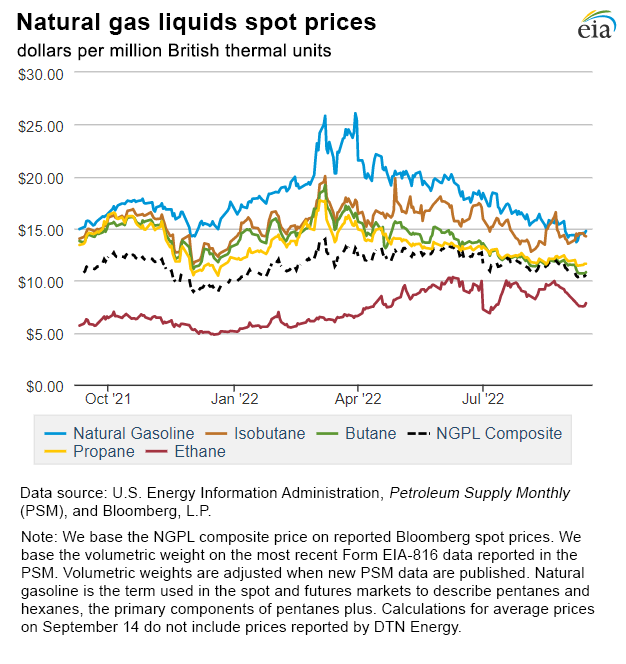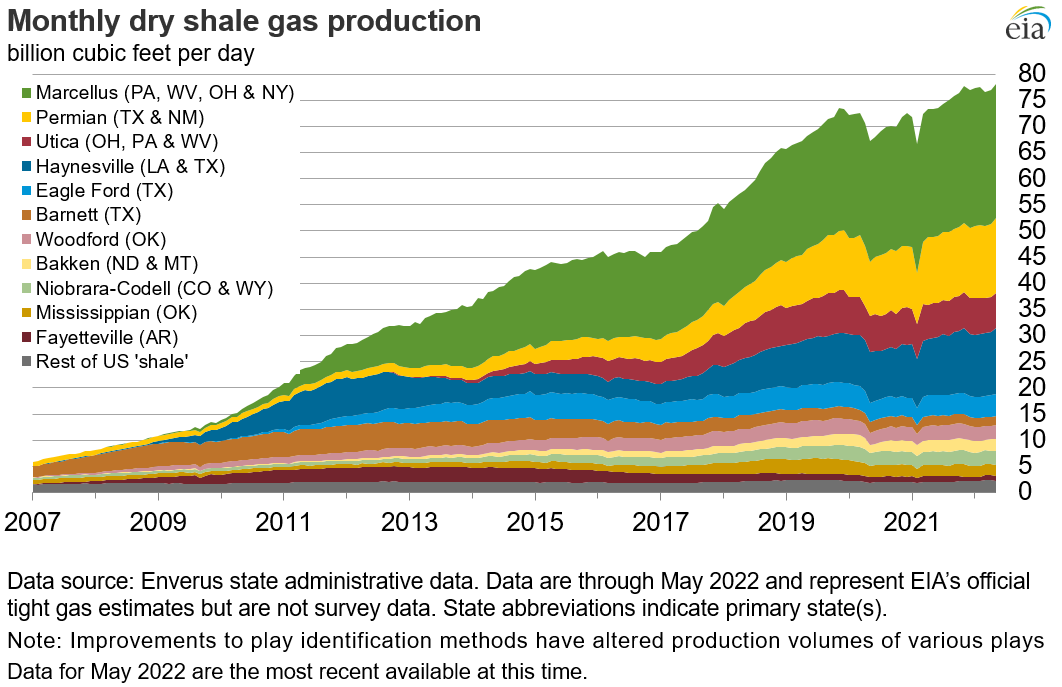In the News:
U.S. natural gas consumption forecast to increase in all sectors in 2022
In our September Short-Term Energy Outlook (STEO), we expect U.S. natural gas consumption in 2022 to increase by 3.6 billion cubic feet per day (Bcf/d) from 2021 levels to average 86.6 Bcf/d for the year, the highest annual natural gas consumption on record. We forecast that U.S. natural gas consumption will increase in all end-use sectors in 2022, led by the electric power sector and the residential and commercial sectors.
In the electric power sector—the sector that consumes the most natural gas—annual U.S. consumption of natural gas increases by 1.2 Bcf/d in 2022 to average 32.1 Bcf/d, which is 0.3 Bcf/d greater than the previous annual record high of 31.8 Bcf/d set in 2020. This sector has, historically, been sensitive to changes in natural gas prices relative to coal prices. Many power providers typically offset their use of natural gas with coal for electricity generation when natural gas prices are relatively high.
However, despite a large increase in natural gas prices this year, U.S. consumption of natural gas in the electric power sector increased in the first eight months of 2022, averaging 33.2 Bcf/d, which is 2.0 Bcf/d higher than the same time in 2021 and 0.4 Bcf/d higher than in 2020. Over the same eight-month period, the natural gas price at the U.S. benchmark Henry Hub in Louisiana averaged $6.56 per million British thermal units (MMBtu) in 2022, compared with $3.43/MMBtu in 2021 and $1.86/MMBtu in 2020.
U.S. consumption of natural gas in the electric power sector has increased in 2022 due to limitations at coal-fired power plants and weather-driven demand. Coal-fired power plants have been limited in their ability to increase power generation due to historically low on-site inventories, constraints in fuel delivery to coal plants, and continued coal capacity retirements. During both a cold January and a hot summer, natural gas was key to meeting electricity demand peaks throughout the country. We expect natural gas consumption in the electric power sector to decline in the fourth quarter of 2022 and in 2023, in part, due to more renewable electricity generation capacity coming online.
We forecast annual U.S. consumption of natural gas in 2022 to increase by 0.9 Bcf/d in the residential sector and by 0.7 Bcf/d in the commercial sector, driven by high consumption in January. January 2022 was particularly cold, resulting in 9% more heating degree days (HDD) compared with the previous 10-year (2012–2021) average. Natural gas consumption in these two sectors averaged 8% higher than the five-year (2017–2021) average in January, averaging 31.0 Bcf/d in the residential sector and 17.8 Bcf/d in the commercial sector. We expect natural gas consumption in the residential and commercial sectors in 2023 to be similar to 2022 levels.
Market Highlights:
(For the week ending Wednesday, September 14, 2022)Prices
- Henry Hub spot price: The Henry Hub spot price rose 56 cents from $8.13 per million British thermal units (MMBtu) last Wednesday to $8.69/MMBtu yesterday.
- Henry Hub futures prices: The price of the October 2022 NYMEX contract increased $1.272, from $7.842/MMBtu last Wednesday to $9.114/MMBtu yesterday. The price of the 12-month strip averaging October 2022 through September 2023 futures contracts climbed 89.9 cents to $7.424/MMBtu.
- Select regional spot prices: Natural gas spot prices rose at most locations this report week (Wednesday, September 7 to Wednesday, September 14). Price increases at major pricing hubs ranged between $0.24 at Transco Zone 6 NY to $0.74 at PG&E Citygate, while the price at SoCal Citygate fell $3.47.
Prices in the West were mostly up this report week except for Southern California. The price at PG&E Citygate in Northern California rose 74 cents, up from $9.09/MMBtu last Wednesday to $9.83/MMBtu yesterday. The price at Sumas on the Canada-Washington border rose 28 cents from $7.79/MMBtu last Wednesday to $8.07/MMBtu yesterday. The price at Malin, Oregon, the northern delivery point into the PG&E service territory, rose 45 cents from $7.75/MMBtu last Wednesday to $8.20/MMBtu yesterday.
The price at SoCal Citygate in Southern California decreased $3.47 from $12.99/MMBtu last Wednesday to $9.52/MMBtu yesterday. The heat wave that covered much of the western United States last week has subsided and temperatures returned closer to normal levels. In the Riverside Area, inland from Los Angeles, temperatures averaged a little more than 80°F this week, which was 12°F lower than last week and only 3°F above normal. Natural gas consumption in the electric power sector in California declined 22%, or 0.7 billion cubic feet per day (Bcf/d) this report week, according to data from PointLogic.
- The price at the Waha Hub in West Texas, which is located near Permian Basin production activities, rose 54 cents this report week, from $6.70/MMBtu last Wednesday to $7.24/MMBtu yesterday. The Waha Hub traded $1.45 below the Henry Hub price yesterday, compared to last Wednesday when it traded $1.43 below the Henry Hub price. In the first half of September, the Waha Hub has traded at an average $1.33 below the Henry Hub price, which compares with $0.22 below the Henry Hub price in the same period a year ago. The differential between the Waha Hub price and the Henry Hub price largely reflects regional pipeline constraints.
- International futures prices: International natural gas futures prices declined this report week. According to Bloomberg Finance, L.P., weekly average futures prices for liquefied natural gas (LNG) cargoes in East Asia decreased $2.88 to a weekly average of $53.19/MMBtu, and natural gas futures for delivery at the Title Transfer Facility (TTF) in the Netherlands, the most liquid natural gas market in Europe, decreased $5.68 to a weekly average of $60.81/MMBtu.
- Natural gas plant liquids prices: The natural gas plant liquids composite price at Mont Belvieu, Texas, fell by 33 cents/MMBtu, averaging $10.42/MMBtu for the week ending September 14. The price of ethane fell 8%, following the natural gas price at the Houston Ship Channel, which fell 7%. The ethane premium to natural gas fell by 50% week over week from 14 cents/MMBtu to 7 cents/MMBtu. The price of ethylene fell 2%, widening the ethylene to ethane premium by 11%. The natural gasoline price rose 2% following the Brent crude oil price, which rose 1%. The isobutane price rose 4%, while the normal butane price fell 6%. The propane price fell 2%, resulting in the propane discount to crude oil increasing by 11%.
Daily spot prices by region are available on the EIA website.
Supply and Demand
- Supply: According to data from PointLogic, the average total supply of natural gas fell by 0.8% (0.9 Bcf/d) compared with the previous report week. Dry natural gas production decreased by 0.3% (0.3 Bcf/d) compared with the previous report week. Average net imports from Canada decreased by 9.6% (0.6 Bcf/d) from last week.
- Demand: Total U.S. consumption of natural gas fell by 3.9% (2.7 Bcf/d) compared with the previous report week, according to data from PointLogic. Natural gas consumed for power generation declined by 8.1% (3.2 Bcf/d) week over week as extreme heat on the West Coast subsided. Industrial sector consumption increased by 0.6% (0.1 Bcf/d), while consumption in the residential and commercial sectors increased by 4.9% (0.4 Bcf/d). Natural gas exports to Mexico increased 3.7% (0.2 Bcf/d). Natural gas deliveries to U.S. LNG export facilities (LNG pipeline receipts) averaged 11.2 Bcf/d, or 0.1 Bcf/d lower than last week.
Liquefied Natural Gas (LNG)
- Pipeline receipts: Natural gas deliveries to LNG export terminals in South Louisiana increased by 0.1 Bcf/d this week to an average of 8.0 Bcf/d, according to data from PointLogic. Deliveries to Texas terminals declined by 0.2 Bcf/d to 2.0 Bcf/d, while natural gas deliveries to other LNG export terminals were essentially flat week over week. Overall natural gas deliveries to U.S. LNG export terminals decreased by 0.1 Bcf/d to an average of 11.2 Bcf/d this report week.
- Vessels departing U.S. ports: Twenty LNG vessels (seven from Sabine Pass, four each from Cameron and Corpus Christi, three from Calcasieu Pass, and one each from Cove Point and Elba Island) with a combined LNG-carrying capacity of 74 Bcf departed the United States between September 8 and September 14, according to shipping data provided by Bloomberg Finance, L.P.
Rig Count
- According to Baker Hughes, for the week ending Tuesday, September 6, the natural gas rig count increased by 4 rigs from a week ago to 166 rigs. The Haynesville and the Permian each added one rig, and two rigs were added in unspecified producing regions. The number of oil-directed rigs decreased by 5 rigs from a week ago to 591 rigs. The Mississippian added one rig, the Haynesville dropped one rig, the Permian dropped three rigs, and two rigs were dropped in unspecified producing regions. The total rig count now stands at 759 rigs, which is 256 more than the same week last year.
Storage
- The net injections into storage totaled 77 Bcf for the week ending September 9, compared with the five-year (2017–2021) average net injections of 82 Bcf and last year's net injections of 78 Bcf during the same week. Working natural gas stocks totaled 2,771 Bcf, which is 354 Bcf (11%) lower than the five-year average and 223 Bcf (7%) lower than last year at this time.
- According to The Desk survey of natural gas analysts, estimates of the weekly net change to working natural gas stocks ranged from net injections of 65 Bcf to 78 Bcf, with a median estimate of 72 Bcf.
- The average rate of injections into storage is 5% lower than the five-year average so far in the refill season (April through October). If the rate of injections into storage matched the five-year average of 10 Bcf/d for the remainder of the refill season, the total inventory would be 3,291 Bcf on October 31, which is 354 Bcf lower than the five-year average of 3,645 Bcf for that time of year.
See also:
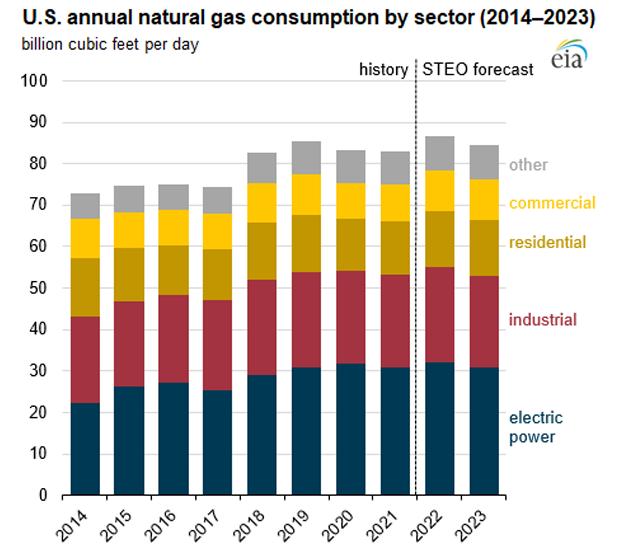
Data source: U.S. Energy Information Administration, Short-Term Energy Outlook (STEO), September 2022
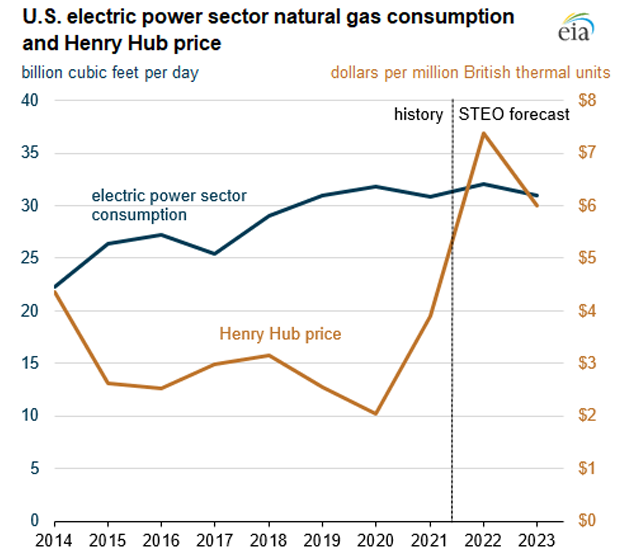
Data source: U.S. Energy Information Administration, Short-Term Energy Outlook (STEO), September 2022
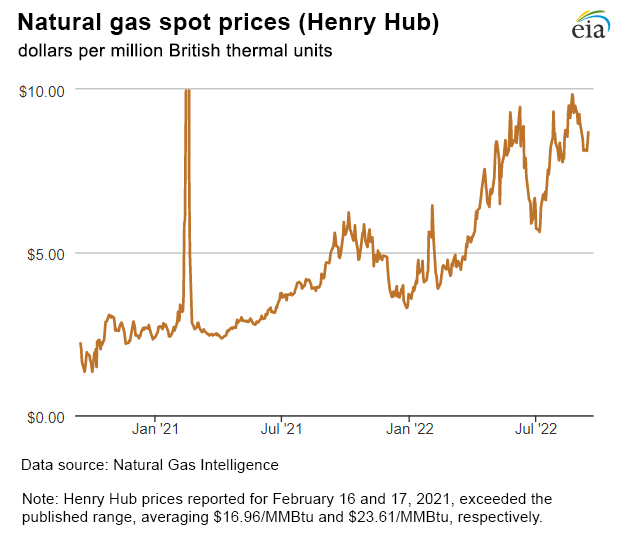
| Spot Prices ($/MMBtu) | Thu, 08-Sep |
Fri, 09-Sep |
Mon, 12-Sep |
Tue, 13-Sep |
Wed, 14-Sep |
|---|---|---|---|---|---|
| Henry Hub |
8.13 |
8.15 |
8.12 |
8.39 |
8.69 |
| New York |
7.31 |
7.11 |
7.48 |
7.76 |
7.80 |
| Chicago |
7.49 |
7.38 |
7.60 |
7.76 |
8.08 |
| Cal. Comp. Avg.* |
9.45 |
8.21 |
8.54 |
8.64 |
9.00 |
| Futures ($/MMBtu) | |||||
| October contract | 7.915 |
7.996 |
8.249 |
8.284 |
9.114 |
| November contract |
7.971 |
8.044 |
8.287 |
8.334 |
9.167 |
| Data source: Natural Gas Intelligence and CME Group as compiled by Bloomberg, L.P. *Avg. of NGI's reported prices for: Malin, PG&E Citygate, and Southern California Border Avg. |
|||||
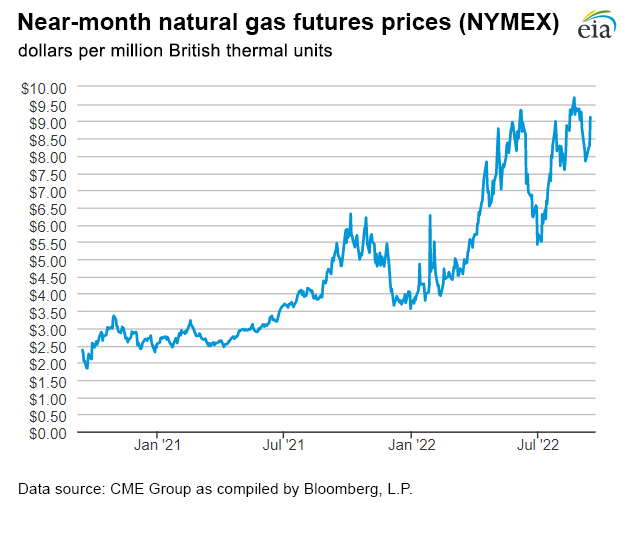
| U.S. natural gas supply - Gas Week: (9/8/22 - 9/14/22) | |||
|---|---|---|---|
Average daily values (billion cubic feet) |
|||
this week |
last week |
last year |
|
| Marketed production | 111.0 |
111.4 |
105.7 |
| Dry production | 99.4 |
99.8 |
93.2 |
| Net Canada imports | 5.3 |
5.8 |
4.7 |
| LNG pipeline deliveries | 0.1 |
0.1 |
0.1 |
| Total supply | 104.8 |
105.7 |
98.0 |
|
Data source: PointLogic | |||
| U.S. natural gas consumption - Gas Week: (9/8/22 - 9/14/22) | |||
|---|---|---|---|
Average daily values (billion cubic feet) |
|||
this week |
last week |
last year |
|
| U.S. consumption | 67.4 |
70.1 |
63.9 |
| Power | 36.8 |
40.1 |
34.8 |
| Industrial | 21.8 |
21.6 |
20.6 |
| Residential/commercial | 8.9 |
8.4 |
8.5 |
| Mexico exports | 5.6 |
5.4 |
5.7 |
| Pipeline fuel use/losses | 6.7 |
6.7 |
6.2 |
| LNG pipeline receipts | 11.2 |
11.2 |
11.1 |
| Total demand | 90.9 |
93.5 |
86.9 |
|
Data source: PointLogic | |||
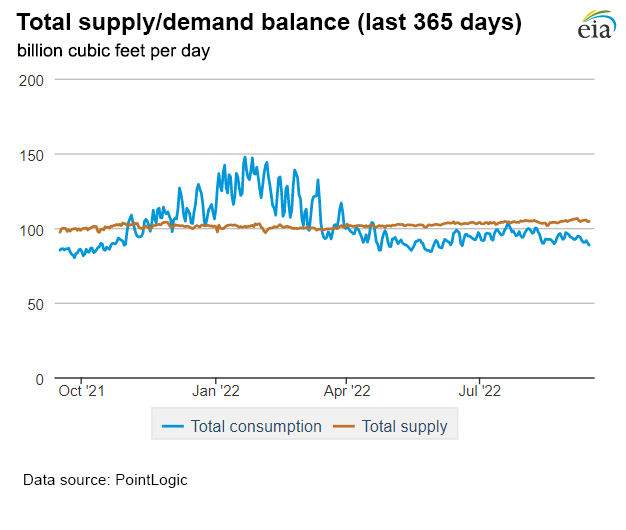
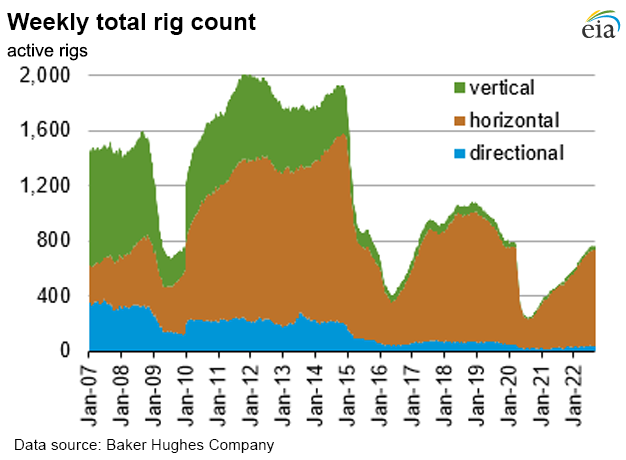
| Rigs | |||
|---|---|---|---|
Tue, September 06, 2022 |
Change from |
||
last week |
last year |
||
| Oil rigs | 591 |
-0.8% |
47.4% |
| Natural gas rigs | 166 |
2.5% |
64.4% |
| Note: Excludes any miscellaneous rigs | |||
| Rig numbers by type | |||
|---|---|---|---|
Tue, September 06, 2022 |
Change from |
||
last week |
last year |
||
| Vertical | 24 |
-7.7% |
-7.7% |
| Horizontal | 692 |
-0.4% |
50.1% |
| Directional | 43 |
10.3% |
168.8% |
| Data source: Baker Hughes Company | |||
| Working gas in underground storage | ||||
|---|---|---|---|---|
Stocks billion cubic feet (Bcf) |
||||
| Region | 2022-09-09 |
2022-09-02 |
change |
|
| East | 661 |
635 |
26 |
|
| Midwest | 809 |
776 |
33 |
|
| Mountain | 163 |
159 |
4 |
|
| Pacific | 235 |
238 |
-3 |
|
| South Central | 904 |
887 |
17 |
|
| Total | 2,771 |
2,694 |
77 |
|
| Data source: U.S. Energy Information Administration Form EIA-912, Weekly Underground Natural Gas Storage Report | ||||
| Working gas in underground storage | |||||
|---|---|---|---|---|---|
Historical comparisons |
|||||
Year ago (9/9/21) |
5-year average (2017-2021) |
||||
| Region | Stocks (Bcf) |
% change |
Stocks (Bcf) |
% change |
|
| East | 728 |
-9.2 |
759 |
-12.9 |
|
| Midwest | 871 |
-7.1 |
876 |
-7.6 |
|
| Mountain | 193 |
-15.5 |
195 |
-16.4 |
|
| Pacific | 240 |
-2.1 |
275 |
-14.5 |
|
| South Central | 962 |
-6.0 |
1,020 |
-11.4 |
|
| Total | 2,994 |
-7.4 |
3,125 |
-11.3 |
|
| Data source: U.S. Energy Information Administration Form EIA-912, Weekly Underground Natural Gas Storage Report | |||||
| Temperature – heating & cooling degree days (week ending Sep 08) | ||||||||
|---|---|---|---|---|---|---|---|---|
HDDs |
CDDs |
|||||||
| Region | Current total |
Deviation from normal |
Deviation from last year |
Current total |
Deviation from normal |
Deviation from last year |
||
| New England | 10 |
-4 |
1 |
9 |
-2 |
-1 |
||
| Middle Atlantic | 2 |
-6 |
-5 |
33 |
9 |
15 |
||
| E N Central | 4 |
-8 |
-7 |
35 |
12 |
15 |
||
| W N Central | 5 |
-13 |
-3 |
46 |
13 |
7 |
||
| South Atlantic | 0 |
-1 |
-1 |
87 |
14 |
15 |
||
| E S Central | 0 |
-1 |
0 |
75 |
10 |
13 |
||
| W S Central | 0 |
-1 |
0 |
98 |
-1 |
-23 |
||
| Mountain | 0 |
-23 |
-2 |
85 |
35 |
24 |
||
| Pacific | 1 |
-7 |
0 |
97 |
61 |
43 |
||
| United States | 2 |
-7 |
-3 |
66 |
19 |
14 |
||
|
Data source: National Oceanic and Atmospheric Administration Note: HDDs=heating degree days; CDDs=cooling degree days | ||||||||
Average temperature (°F)
7-day mean ending Sep 08, 2022
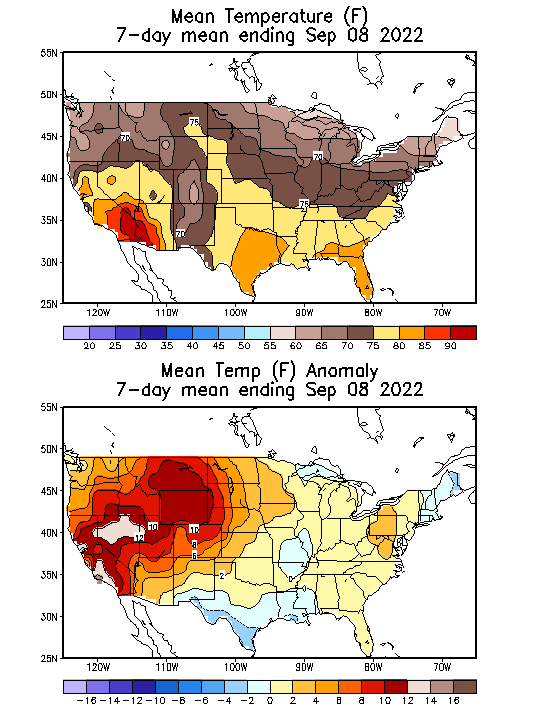
Data source: National Oceanic and Atmospheric Administration
Deviation between average and normal temperature (°F)
7-day mean ending Sep 08, 2022

Data source: National Oceanic and Atmospheric Administration

